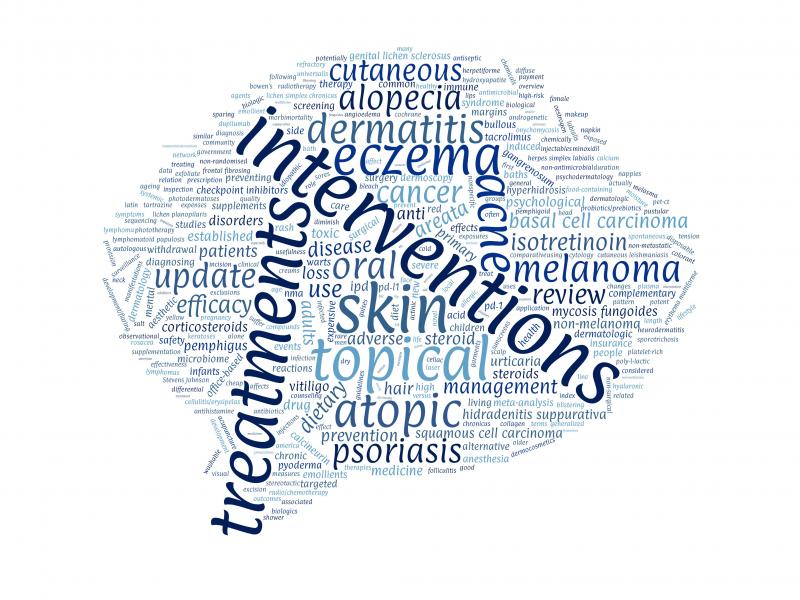In September 2017 the Cochrane Skin Group celebrated running for 20 years, and we are proud of the 100+ high quality systematic reviews that have been produced over that period. Our expanding portfolio, and the increasing number of non-Cochrane systematic reviews, meant that we needed to take stock and prioritise Cochrane Skin reviews going forward. We need to ensure that Cochrane Skin reviews are the reviews most needed by our stakeholders. We are particularly interested in reviews that are key to informing guidelines or policy, or that are funded by our stakeholders. We are also interested in doing methodologically challenging systematic reviews that involve techniques such as network meta-analysis, individual patient meta-analysis and diagnostic test accuracy reviews.
|  |
With this in mind, we undertook a prioritisation exercise, asking for suggestions from a wide range of stakeholders about what reviews or updates they would like us to prioritise over the next two years. You can read more about it here, in a Cochrane blog, or in a publication in the BJD. Our Deputy Co-ordinating Editor, Dr Bob Boyle, led the project, which began in January 2017. Our aim was to identify titles which were 1) key to informing guidelines or policy, 2) not already well-covered by a Cochrane systematic review, and 3) of maximum clinical importance and greatest relevance to patients and health care funders.
Methodology
We consulted a wide range of stakeholders (such as professional societies, guideline development groups, the CSG membership and patient representatives) to ask for title suggestions. We then reviewed prioritisation exercises undertaken by the James Lind Alliance (JLA) and others and suggestions for further research made by national and international guideline groups. Furthermore, skin disorders identified as carrying a significant global burden in the Global Burden of Disease (GBD) project and their representation in the CSG portfolio were considered and gaps identified. We were open to suggestions of completely new review questions that had never been registered, as well as updates of existing reviews where there may be important new evidence. We asked that suggestions were about healthcare interventions, i.e. the effectiveness of different approaches to preventing, treating or diagnosing skin disease. After gathering all title suggestions and incorporating wider dermatological research results, a final shortlist was sent to our international editors, who rated their preferences. The full document can be downloaded here.
Prioritisation exercise 2020
The prioritisation process has been repeated in 2020. We used the same mixed methods that we used in our first prioritisation exercise in 2017, with the addition of points 4 and 5 below:
- We contacted professional societies, guideline development groups, the CS membership and patient representatives to ask for review title suggestions, using an online survey tool (Survey Monkey). The text of the survey including the questions asked, a list of the organisations contacted, and a summary of respondents, is shown in Appendix 1. We also included suggestion from our South American Satellite and those suggested by email since 2017.
- We reviewed prioritisation exercises relevant to our scope undertaken by the James Lind Alliance (JLA) and others. We also reviewed suggestions for research made by national and international guideline groups.
- We analysed Global Burden of Disease data up to 2017 for disease areas within our scope.
- We undertook a search of CENTRAL to identify recently published reports of studies within our scope.
- We collated download information, citation data and Altmetric scores for our existing portfolio of review titles.
We gathered all this information into a document, with summaries for each condition or topic area, and suggestions for a shortlist of titles or updates that was sent to our international editors to rate their preferences. The final results were discussed in March 2020 and can be found here.
Useful links:
Priority Setting Partnerships
Uncertainties and gaps identified by the Acne PSP
Uncertainties and gaps identified by the Cellulitis PSP
Uncertainties and gaps identified by the Eczema PSP
Uncertainties and gaps identified by the Epidermolysis bullosa PSP
Uncertainties and gaps identified by the Hair Loss PSP
Uncertainties and gaps identified by the Hidradenitis suppurativa PSP
Uncertainties and gaps identified by the Hyperhidrosis PSP
Uncertainties and gaps identified by the Lichen Sclerosus PSP
Uncertainties and gaps identified by the Psoriasis PSP
Uncertainties and gaps identified by the Treatment of Pemphigus and Pemphigoid PSP
Uncertainties and gaps identified by the Vitiligo PSP
The Global Burden of Disease Project (GBD) with the WHO has identified 15 skin conditions within the scope of the Cochrane Skin Group that will help to guide our efforts. In the order in which they have an effect on DALYs (disability adjusted life years) up to 2017: atopic dermatitis, psoriasis, urticaria, fungal infections of skin, nails and scalp, viral infections of the skin, acne vulgaris, bacterial infections of the skin (pyoderma and cellulitis), contact dermatitis, malignant skin melanoma, non-melanoma skin cancer, pruritus, alopecia areata, cutaneous and mucocutaneous leishmaniasis, seborrhoeic dermatitis, and leprosy.
The International League of Dermatology Societies (ILDS) have launched an initiative to address the challenge of achieving global skin health and have identified 9 criteria which should guide progress with NMSC, acne and psoriasis.
